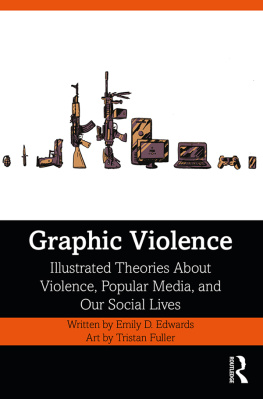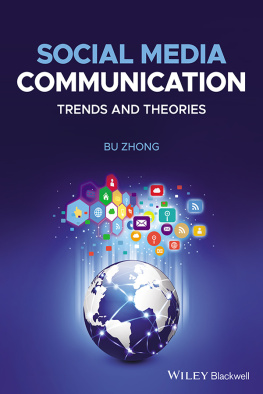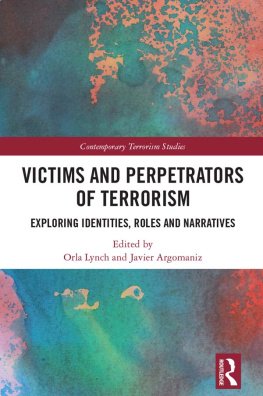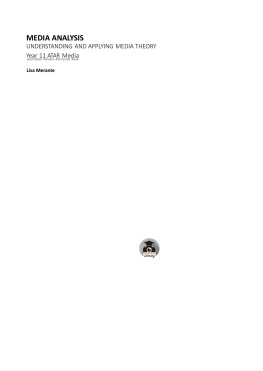I interviewed many people, was a regular nuisance at my universitys library, and pestered friends, family, students, and professional colleagues for their wisdom as I was developing this book. I appreciate everyones patience. I owe special gratitude to my husband, Doug Mokaren, and my friend and colleague, Dr. Rose Kundanis, for reading draft chapters, and my colleagues at the University Film and Video Association for offering ideas and encouragement. I deeply appreciate the contributions of former students, who told me stories about how violence intruded on their lives or the lives of loved ones and the ways they thought media were a factor. Thanks also to my daughter, Marissa Mokaren, for reading and contributing to walkthroughs for the sequential art. I especially want to thank my former graduate student, now professional colleague, Brian Fuller, for introducing me to his talented son, Tristan Fuller. I also want to thank Arts-Greensboro and Textbook and Academic Authors Association for supporting a project that straddled the boundaries of art, journalism, and traditional research. Finally, I want to thank my publisher for taking a risk on a book that includes comics as explanations for the highly abstract narratives of media theory.
1
The Characteristics of Story
Ask any news editor, screenwriter, movie producer, journalist, drama instructor, or graphic novelist for the essence of story and these people will likely tell you that the core of any story is a character in conflict . Most stories involve a protagonist (the main character) with a goal and the conflicts encountered when something or someone prevents the protagonist from achieving that ambition. Without conflict, a storyteller cannot build the necessary tension to create plot. Media professionals have additionally embraced the notion that if conflicts are not externalized into action, the story becomes static and talky, rather than dramatic, visual, and emotionally compelling. Dramatic conflict is heightened with urgency. If a character desperately wants to achieve a goal, and some obstacle is thrown in the way, the dramatic tension heightens in direct proportion to that emotional intensity (Blum, 1995, p. 82). Time-honored advice for development of screenplays has been to recognize that conflict has primal power for stories, so a good writer will fan all the possible flames of conflict (Armer, 1993). Conflict may not always lead to violence. However, conflict is the root from which violence can grow. As the centerpiece of storytelling, understanding conflicts and their resolutions are key to understanding story violence.
We can all identify with conflict; it is a part of life. An argument with a family member, disagreements with coworkers, disputes with neighbors, a fight with city council, the road rage of motorists, the rejection of a lover: the list of potential conflicts can get quite long. Happily, not every conflict rises to the level of violence, but all too often media stories demonstrate violent methods for conflict resolution. While violence often has a starring role in popular media stories, violence was also central to mythology, drama, fairy tales, and folklore long before it was championed in modern media. Violence was the go to resolution in stories told generations before arrival of film, television, computer games, internet, and social media.
You will notice that I frequently substitute the word story where media theories have historically used the phrases media message or media contents. Story is useful because it emphasizes the often dramatic nature of cultural messages and makes the human construction of media contents more evident. Some might question this substitution, asking, Where is the story in a recipe or instruction manual? Where is the protagonist? Where is the conflict? The story may not always be obvious but is often implied. In the case of a cake recipe, the protagonists are the readers, imagining all that needs to be accomplished as they embark on the journey of making a cake, encountering the series of tasks to be completed and complications to overcome before that final triumphant or disastrous moment when cakes come out of the oven. Admittedly, some stories are more clearly dramatic. Story is not synonymous with lie , which is a deliberate departure from fact in an effort to mislead. My use of the word story simply acknowledges that people must choose how to explain the world they experience. All the narratives people tell are fabrications. They are human creations that might lead to a better understanding of eventsor make them incomprehensible. Media stories can be as short as a headline, a single photo, or a one-sentence flash fiction tale. Longer form stories are typically threads of many smaller stories woven into a larger media tapestry. Stories may be as long as a feature film, a multi-season television series, a feature documentary, a continuing computer game, or a novel franchise.
Though stories are human constructions, some media theories we will examine suggest it is the other way around, too. Stories help construct the human psyche and it is the violent stories that leave the largest dents.
Defining Violence
The literature about popular media influence on social violence is extensive. While there may be disagreement in the research, one point of consensus is that American media circulate a lot of violent stories to a vast, worldwide audience. However, scholars have varying definitions for the media violence we observe and the social violence we experience. In some cases, research limits media violence to depictions of overt physical human aggression that maims or kills others. Many studies have widened this definition to include threat, so media violence is defined as the depiction of overt physical action that hurts or kills or threatens to do so (Signorelli Gerbner, 1988, p. xi). The three-year National Television Violence Study (NTVS) defined violence as any overt depiction of a credible threat of physical force or the actual use of such force intended to physically harm an animate being or group of such beings (Anderson et al., 2003, p. 81). The British Broadcasting Corporations definition of violence is any action of physical force, with or without a weapon, used against oneself or another person, where there is an intent to harm, whether carried through or merely attempted and whether the action caused injury or not (BBC, Broadcasting Standards Commission Independent Television Commission, 2002).
Many researchers agree that depictions of violence involve the willful human intent to cause harm to another person or people; some will also include cruel human violence against animals, but generally stop short of including animal predators killing other animals for food or survival. Even animal violence is problematic when considering the brutality in movies like Jaws (1975), Jurassic Park (1993), Jurassic World (2015), and the various versions of King Kong (1933, 1976, 2005) when monster-sized creatures annihilate human victims and each other with what seems like bloody delight. We can argue that this violence appeals to the blood lust of human audiences whose ancestors staged vicious events like dog fighting, cock fighting, and bear baiting for entertainment. The human-created and genetically manipulated dinosaurs envisioned for Jurassic Park and its sequels are not purely a scientific fascination of the movies characters about extinct creatures but include an attraction to the thrill of primeval danger. When the ancient threat of dinosaurs no longer seems exciting enough for theme park visitors in Jurassic World , the films scientists depart from natures design to genetically manipulate DNA, manufacturing bigger, meaner, more ruthless creatures that never existed in nature. Indominus, the gigantic dinosaur created as the star attraction for Jurassic World , had a mysterious genetic mixture that included the cunning of Velociraptors (raptors), giving Indominus the drive to hunt and kill for pleasure as well as problem-solving skills and aspirations for vengeance. Indominus functions as a massive and vicious Other that the films human characters can destroy without guilt.








